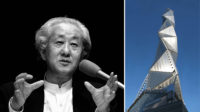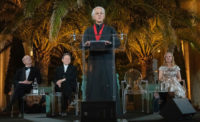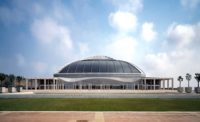Tribute: Curator and Writer Aric Chen Remembers the Late Arata Isozaki

Architects & Firms
The first time I met Arata Isozaki was in 2013. I came to his home in the posh Tokyo neighborhood of Azabu, where he appeared wearing a dark yukata, with his silver hair characteristically slicked back in a short, neat ponytail. The apartment was light and muted, its living room furnished with his well-known Marilyn chairs, a tatami platform, an Eames lounger, and a large Oba-Q lamp designed by his good friend Shiro Kuramata, who had passed away in 1991.
The home was located about midway between the South Korean and Chinese embassies—a detail worth noting when I recall how he and his longtime partner, the gallerist Misa Shin, would sometimes complain, with a combination of humor and resignation, about the racket they had to endure each weekend as right-wing Japanese nationalists shuttled from the embassy of one Asian neighbor to the other, to protest whatever the latest offense was.
That Isozaki found himself in this position was somehow hilariously poetic. He was a transnationalist if there ever was one, an iconic Japanese architect whose mind seemed incapable of drawing borders. (And, as it happens, Shin is of Korean parentage, while Isozaki was active in China—including work on his design for the Museum of the War of Chinese People’s Resistance Against Japanese Aggression, as the Chinese refer to World War II.) Isozaki was defiantly independent, refusing throughout his career to join professional associations or to take teaching positions or, after he turned 60, to accept honorary titles or awards (his 2019 Pritzker Prize was an exception) or even to own property (the Azabu apartment was a rental).

Team Disney Building (1991) in Orlando. Photo © Kochi Prefecture, Ishimoto Yasuhiro Photo Center, click to enlarge.
He was equally hard to pin down through his work. Despite creating some of the most iconic images associated with Metabolism, he refused to join that 1960s group. His later work would be described as Postmodern, but he was not a Postmodernist. He referenced ideas from structuralism to cybernetics to ma—the Japanese concept of “space-time” or the in-between—while mixing in avant-garde theater and French philosophy. He was proud of being an early champion of Zaha Hadid, a fellow “non-logocentric” architect, as he described her to me, using a term borrowed from Derrida. He was known for his buildings, but also wrote prolifically, curated exhibitions, and designed everything from the giant robots at Expo ’70 in Osaka and New York’s storied Palladium nightclub to a teahouse for the London-area home of John Lennon and Yoko Ono (which was never installed, and whose timber components, made by a Japanese master craftsman, are presumably still somewhere waiting to be found).
Isozaki always spoke softly, almost under his breath. However, he did it with focus and the slightest tinge of mischief, as if what he was telling you was only half the story, and he knew that you knew it. I had a quixotic impulse to figure him out, and it led me to become something of a groupie. I followed him to Kyoto, where he gave a talk with Peter Cook; to his country house in Karuizawa (which had been owned, I believe, by his late wife, the artist Aiko Miyawaki); to his Pritzker Prize ceremony at Versailles; and to Okinawa, where he and Shin moved in 2017 for the warmer weather. I would also meet with them in Hong Kong and Shanghai when I was living in those cities, and they were passing through town.
The last time I saw Isozaki was toward the end of 2019, shortly before the pandemic. That time, we were in his hometown of Oita for the opening of an exhibition at the Oita Art Museum that he and Shin had invited me to curate. The show focused on his nonbuilding projects, and, while we wound up calling it Arata Isozaki: Third Space, I remember thinking even then that it would have been just as good, if not even more appropriate, to have given it the title that Isozaki initially suggested: Arata Isozaki: Enigma.



